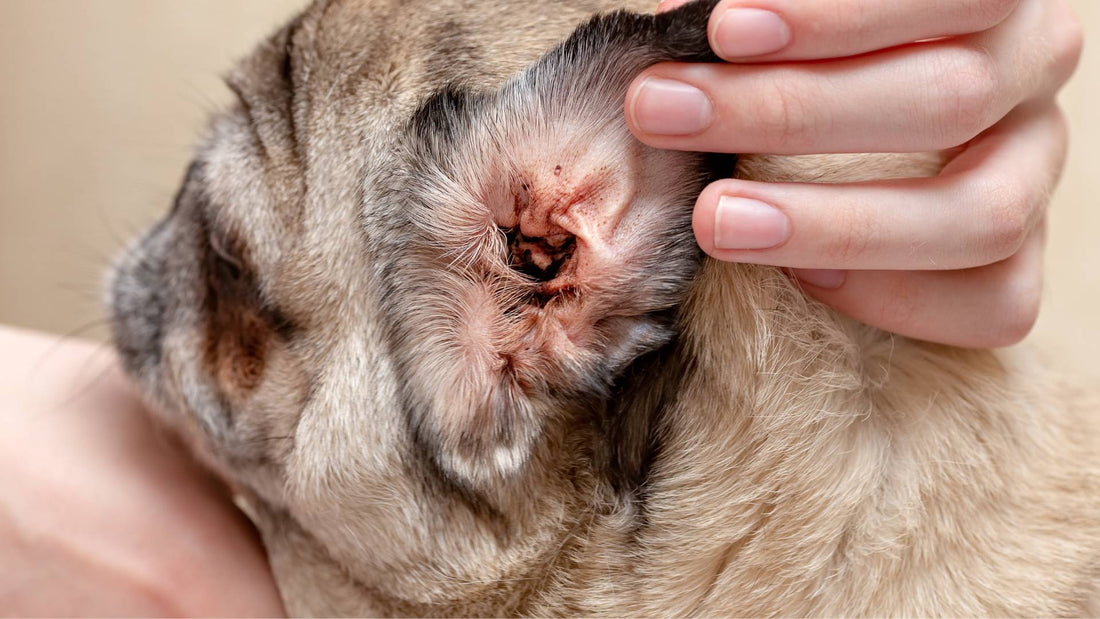
Ear Mites in Dogs
Ear mites are tiny parasites that can cause significant discomfort and irritation for dogs. Often residing in the ear canal, these pests are difficult to spot with the naked eye but can lead to noticeable symptoms that alert dog owners to their presence. If left untreated, ear mites can cause serious ear infections and other complications. In this article, we'll explore the common signs and symptoms of ear mites in dogs, helping you recognise the telltale signs of an infestation.
Table of Contents
- What are ear mites?
- What are the symptoms of ear mites in dogs?
- How do dogs get ear mites?
- Can humans catch ear mites from dogs?
- What do ear mites look like in dogs?
- How long does it take to get rid of ear mites in dogs?
- Are there natural remedies for ear mites in dogs?
- Can ear mites cause permanent damage to a dog’s ears?
- How can I prevent my dog from getting ear mites?
What are ear mites?
Ear mites are tiny, parasitic creatures that can live in the ears of many animals, such as dogs, cats, and rabbits. The most common type that affects pets is called Otodectes cynotis. These mites are very small, usually about 0.3 to 0.5 millimetres long, so they are hard to see without a microscope. They belong to the same group as ticks and other mites, known as Acari, which is part of the larger family of arthropods, the same family that includes insects and spiders.
What are the symptoms of ear mites in dogs?
Ear mites are microscopic parasites that can cause a range of uncomfortable symptoms in dogs. These tiny invaders often go unnoticed until they cause noticeable irritation and distress.
- Intense Scratching and Rubbing: Dogs may scratch their ears excessively or rub their ears against furniture, the ground, or other objects to relieve itching caused by the mites.
- Head Shaking: Frequent and vigorous head shaking is a common sign as the dog tries to alleviate discomfort and irritation.
- Ear Discharge: There may be a dark, crumbly discharge resembling coffee grounds, which is a mix of earwax, blood, and mite debris. This discharge often has a strong odour.
- Ear Redness and Inflammation: The ear canal may appear red and inflamed due to irritation from the mites and scratching.
- Scabs or Crusts: Scabs or crusts may form around the ears, a result of scratching or secondary infections.
- Hair Loss Around Ears: Due to frequent scratching and rubbing, there may be hair loss around the ear area.
- Sensitivity or Pain: The dog may show signs of discomfort when the ears are touched, indicating sensitivity or pain.
- Behavioural Changes: Some dogs may become more irritable or restless due to the constant discomfort.
- Hearing Loss: In severe cases, the infestation and resulting inflammation can temporarily affect the dog's hearing.
How do dogs get ear mites?
Dogs can get ear mites through direct contact with other infected animals. These tiny parasites are highly contagious and can easily spread from one pet to another, especially in environments where multiple animals are in close proximity, such as homes with multiple pets, kennels, shelters, or grooming facilities.
Ear mites can also be transferred indirectly through contaminated objects like bedding, grooming tools, or toys. When an infected animal shakes its head or scratches, mites can be dislodged and land on surfaces or other animals, facilitating their spread.
While ear mites are more commonly found in cats, they can just as easily infest dogs. Puppies and young dogs are particularly susceptible because they often have closer interactions with their littermates and are more likely to share sleeping areas. Outdoor activities can also expose dogs to ear mites, especially if they come into contact with stray animals or wildlife that carry the parasites.
Can humans catch ear mites from dogs?
Humans are very unlikely to catch ear mites from dogs. While ear mites, specifically Otodectes cynotis, primarily infest animals such as dogs, cats, and other mammals, they are not well adapted to live on humans.
In rare cases, a mite might crawl onto a person from an infected pet and cause minor, temporary itching or irritation, but they cannot survive or reproduce on human skin. This is because the human body does not provide the necessary environment and conditions that these mites need to thrive.
What do ear mites look like in dogs?
Although the mites themselves are too small to be seen without a microscope, a veterinarian can diagnose an ear mite infestation by examining a sample of the ear discharge under a microscope. There, the mites may appear as tiny, white or light-coloured specks with eight legs and a somewhat oval body.
How long does it take to get rid of ear mites in dogs?
The time it takes to get rid of ear mites in dogs can vary depending on several factors, including the severity of the infestation, the type of treatment used, and how quickly treatment begins. Here’s a general overview:
- Initial Treatment: Effective treatment usually starts showing results within a few days. Medications like ear drops, topical treatments, or oral medications are commonly prescribed by veterinarians. These treatments target and kill the mites, and you may start to see improvement in your dog's symptoms within 3 to 5 days.
- Complete Eradication: To fully eliminate ear mites and ensure all stages of their life cycle are addressed (eggs, larvae, nymphs, and adults), treatment typically continues for 2 to 4 weeks. This duration helps to ensure that any newly hatched mites are also killed.
- Follow-Up Care: After the initial treatment period, a follow-up visit to the veterinarian is often recommended to confirm that the mites are completely gone and to check for any secondary infections or complications.
- Cleaning and Prevention: Proper cleaning of the dog's ears and any contaminated environments, such as bedding and grooming tools, is essential. This helps to prevent re-infestation and ensures that the treatment is effective.
Overall, while improvement can be seen relatively quickly, it’s important to complete the full course of treatment and follow your veterinarian's advice to ensure that the ear mites are entirely eradicated.
Are there natural remedies for ear mites in dogs?
Yes, there are several natural remedies that some pet owners use to help manage ear mites in dogs. However, it's important to note that while these remedies may offer relief and assist in treatment, they are generally not a substitute for veterinary care, especially in severe cases. Here are some commonly used natural remedies:
- Essential Oils: Certain essential oils, such as neem oil, lavender oil, and tea tree oil, have natural anti-parasitic properties. Diluted properly, these oils can be applied topically to the ear area. However, essential oils should be used with caution as some can be irritating or toxic to pets if not used correctly.
- Apple Cider Vinegar: Apple cider vinegar is believed to have antifungal and antibacterial properties. It can be diluted with water and used as an ear rinse to help clean the ears and potentially deter mites. However, it should not be used if the ear canal is already inflamed or has open sores.
- Coconut Oil: Coconut oil has natural antibacterial and anti-inflammatory properties. It can be applied to the ear canal to soothe irritation and may help in managing ear mites. Ensure it’s applied in moderation and does not exacerbate any existing inflammation.
- Aloe Vera: Aloe vera has soothing and healing properties that can help calm irritated skin. A small amount of pure aloe vera gel can be applied to the outer ear area, but it should not be inserted into the ear canal.
- Garlic: Garlic is known for its natural anti-parasitic properties. Some dog owners use garlic oil as a topical treatment. However, garlic should be used with caution, as it can be toxic to dogs in large amounts.
- Olive Oil: Olive oil can help to soften and loosen debris in the ear canal, making it easier to clean. It can be warmed slightly and used as a gentle ear rinse, but it’s not a treatment for the mites themselves.
Can ear mites cause permanent damage to a dog’s ears?
Yes, ear mites can potentially cause permanent damage to a dog’s ears if left untreated or if the infestation is severe. Here’s how ear mites can lead to long-term issues:
- Chronic Inflammation: The irritation and inflammation caused by ear mites can become chronic if not addressed promptly. Prolonged inflammation may lead to thickening of the ear canal lining and scarring, which can affect the ear’s function.
- Secondary Infections: Ear mites can create an environment conducive to secondary bacterial or fungal infections. Repeated or severe infections can damage the ear tissues and lead to complications such as chronic otitis externa (ear inflammation).
- Hearing Loss: Persistent inflammation and infection can potentially lead to hearing loss. The accumulation of debris, inflammation, and damage to the ear canal can impair a dog’s ability to hear.
- Ear Hematomas: Intense scratching and head shaking caused by ear mites can lead to ear hematomas, which are swollen areas filled with blood. These can cause further discomfort and may require surgical intervention. If not treated, they can lead to deformities or permanent damage to the ear structure.
- Eardrum Damage: In severe cases, the continuous irritation and infection can affect the eardrum, potentially leading to perforation or other damage. This can affect hearing and may require more complex veterinary treatment.
How can I prevent my dog from getting ear mites?
Preventing ear mites in dogs comes from good hygiene. Regularly clean your dog’s ears with cooled boiled water and cotton wool to remove excess wax and debris that can attract mites. While doing this, check your dog's ears frequently for any signs of irritation or unusual discharge.
For any further help and advice please contact us on 01484 246420 and why not join our social media channels and online community on Instagram, Facebook or YouTube.
With Wags and Woofs,
Laura, Dolly & Reggie



